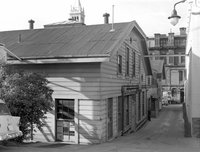Lawrence Berkeley National Laboratory
|
|
Berkeley_Lab_view.jpg
The Ernest Orlando Lawrence Berkeley National Laboratory (LBNL), formerly the Berkeley Radiation Laboratory and usually shortened to Berkeley Lab or LBL is a U.S. Department of Energy national laboratory in Berkeley, California conducting unclassified scientific research. It is managed and owned by the University of California.
The site consists of 76 buildings located on 183 acres (0.7 km²) on the hills of the University of California, Berkeley campus. Altogether, it has some 4,000 employees, of which about 800 are students. Each year, the Lab also hosts more than 2,000 participating guests.
The Laboratory includes 15 divisions that are organized within the areas of Computing Sciences, Energy Sciences, Biosciences, General Sciences, and Resources and Operations. Many research projects are staffed and supported by multiple divisions, with computational and engineering integrated across the biosciences, general sciences and energy sciences.
History
The lab was founded in 1931 by Ernest Orlando Lawrence as a site for centering physics research around his new instrument, the cyclotron (a type of particle accelerator for which he won the Nobel Prize in Physics). Throughout the 1930s, Lawrence pushed to create larger and larger machines for physics research, courting private philanthropists for funding, often with the promise of developing new forms of chemotherapy using radioisotopes produced by the cyclotrons. After the laboratory was scooped on a number of fundamental discoveries that they felt they ought to have made, the "cyclotroneers" began to collaborate more closely with the theoretical physicists in the Berkeley Department of Physics, led by Robert Oppenheimer. The lab moved to its site on the hill above campus in 1940 as its machines became too big, and potentially too dangerous, to house on the university grounds.
Oak_Ridge_Y-12_Alpha_Track.jpg
Lawrence courted government as his sponsor in the early years of the Manhattan Project, the American effort to produce the first atomic bomb during World War II, and along with the MIT Radiation Laboratory (which helped to develop radar), ushered in the era of "Big Science". Using the newly created 184-inch Cyclotron as a mass spectrometer, Lawrence and his colleagues developed the principle behind the electromagnetic enrichment of uranium, which was put to use in the calutrons (named after the university) at the massive Y-12 facility in Oak Ridge, Tennessee and contributed some of the precious fissile material used for the "Little Boy" bomb which was dropped on Hiroshima, Japan.
After the war, Lawrence sought to maintain strong government and military ties at his lab, which became incoporated into the new system of Atomic Energy Commission (now Department of Energy) National Laboratories, but in the early 1950s set out that the lab's purpose would be primarily non-classified research, with classified weapon research taking place at Los Alamos National Laboratory (established during the war) and the new Lawrence Livermore National Laboratory, established by Lawrence and Edward Teller from what was originally a splinter from the original Radiation Laboratory. Some weapons-related and collaborative research continued at LBL until the 1970s, however.
From the 1950s through the present, the laboratory has maintained its status has a major international center for physics research, and has also diversified its research program into almost every realm of scientific investigation. Along with its historical specialty of accelerator research and nuclear physics, the laboratory currently maintains divisions which investigate nuclear fusion, earth sciences, genomics, health physics, computer science, materials science, and environmental science, among other things. The laboratory is also the site of the a number of National User Facilities, including the Advance Light Source, National Center for Electron Microscopy, National Energy Research Scientific Computing Center, and the Energy Sciences Network.
Accolades
Notable scientific accomplishments at the Lab since World War II include the observation of the antiproton and the discovery of several transuranic elements.
Since its inception, nine researchers at this Lab (Ernest Lawrence, Glenn T. Seaborg, Edwin M. McMillan, Owen Chamberlain, Emilio G. Segrè, Donald A. Glaser, Melvin Calvin, Luis W. Alvarez, and Yuan T. Lee) have been awarded the Nobel Prize.
Elements discovered by laboratory physicists include Astatine, Neptunium, Plutonium, Curium, Americium, Berkelium*, Californium*, Einsteinium, Fermium, Mendelevium, Nobelium, Lawrencium*, Dubnium, and Seaborgium*. Those elements listed with asterisks (*) are named after the laboratory or some of its principle scientists. The element Technetium was discovered after Ernest Lawrence gave Emilio Segrè a molybdenum strip from the LBL cyclotron.
External links
- Official site (http://www.lbl.gov/)
- Lawrence and His Laboratory: A Historian's View of the Lawrence Years (http://www.lbl.gov/Science-Articles/Research-Review/Magazine/1981/) by the respected historians of science J. L. Heilbron, Robert W. Seidel, and Bruce R. Wheaton.
Template:U.S. National Labsde:Lawrence Berkeley National Laboratory fr:Berkeley Lab ja:ローレンス・バークレー国立研究所

